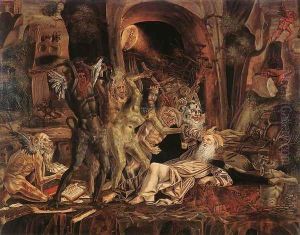Bernardino Parenzano Paintings
Bernardino Parenzano, sometimes also referred to as Bernardino da Parenzo, was a Renaissance painter and miniaturist, born around 1450 in Parenzo, now known as Poreč, a town located in modern-day Croatia, which was then part of the Venetian Republic. His work and life are less documented than those of his more famous contemporaries, leading to a biography that must be pieced together from the scant records and artworks attributed to him.
Parenzano's artistic journey presumably began in his hometown, but like many artists of his time, he traveled to Italy to further his training and career, getting exposed to the burgeoning Renaissance movement. The period was marked by a renewed interest in the classical past, humanism, and the natural world, themes that found their way into Parenzano's work. Although specific details about his apprenticeship and early career are scarce, it is believed that he was influenced by the Venetian school, known for its vibrant use of color and emphasis on atmospheric effects.
Throughout his career, Parenzano worked on various commissions, including religious panels, portraits, and illuminated manuscripts. His style incorporated elements of the early Venetian Renaissance, with particular attention to detail and a delicate handling of color and light. One of his notable works is a series of frescoes in the Church of San Francesco in Parenzo, showcasing his skill in creating narrative scenes filled with emotional depth and spiritual intensity.
Despite his contributions to the art world, Bernardino Parenzano's work was somewhat overshadowed by the luminaries of his time, such as Bellini and Mantegna. However, his art provides valuable insights into the transitional period of the late 15th century, bridging the gap between the Gothic and Renaissance styles. He died in 1500, leaving behind a legacy that, while not as widely recognized, is appreciated for its contribution to the development of Renaissance art.
Today, Bernardino Parenzano's surviving works are considered important for the study of the period's art history, offering glimpses into the aesthetic and thematic shifts that characterized the Renaissance era. His paintings, particularly those in his native region, remain a testament to the vibrancy and diversity of 15th-century Italian art.
